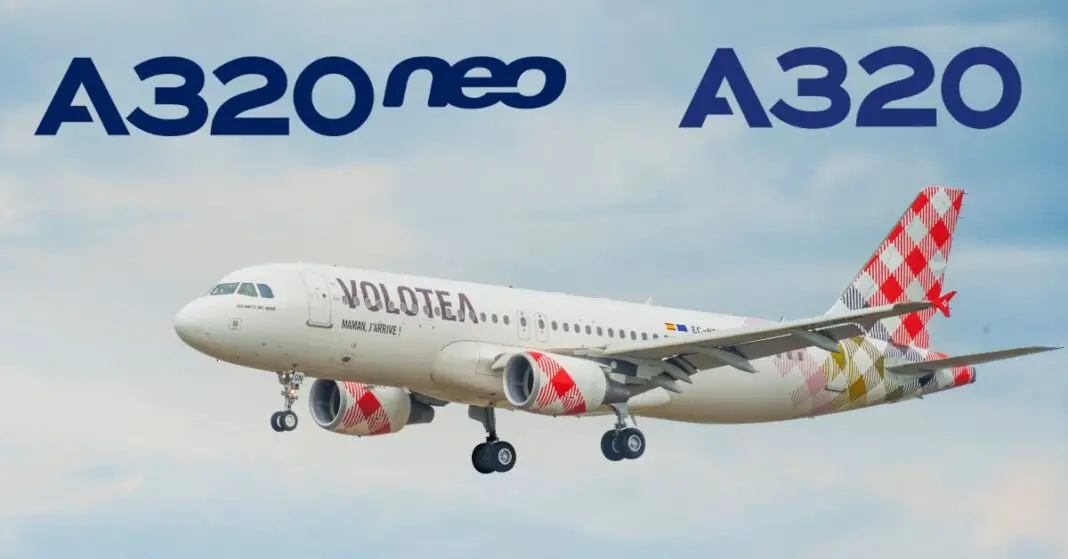The aviation industry has evolved spectacularly over the years, with significant advancements in technology and design shaping the planes that traverse our skies. Key among these pioneering developments are the Airbus A320 and its upgraded version, the Airbus A320neo. This text navigates the specifics of these two aircraft, which, despite sharing a common base, diverge regarding efficiency, design, and performance.
Our journey will take us through the technical makeup of both planes, the innovative features of the A320neo, resulting fuel efficiency, comparative flight performance, and economic implications. So, strap yourselves in as we soar into the fascinating world of these two marvels of modern aviation.
Table of Contents
Overview of A320 and A320neo
Gear up, tech enthusiasts! In the expansive realm of aviation technology, two titan aircraft stand out—the Airbus A320 and its newer variant, the A320neo. These marvels of cutting-edge technology have revolutionized the aerospace industry. So, let’s sped no more time and probe into the technological prowess of Airbus’s pride and joy.
The Airbus A320
Manufactured by the European corporation Airbus, the A320 is renowned as the first commercial airplane to deploy digital fly-by-wire flight control systems. Core specs include a well-proportioned fuselage with a diameter of 3.95 meters. This ‘double-bubble’ design optimizes cargo and cabin space. The wingspan measures an impressive 34.1 meters, accommodating lift generation for its weight.
A320’s muscle lies in its two turbofan engines; the CFM International CFM56-5 or IAE V2500 with thrust ratings between 111–120 kN. The airliner clocks a cruising speed of Mach 0.78 (828 km/h), ensuring timely arrivals.
With a range of approximately 3,300 nautical miles, the A320 comfortably bridges continental distances. An advanced flight deck with state-of-the-art avionics illuminates the technological brilliance within Airbus’s engineering prowess.
The Airbus A320neo
Advancements in technology fuel continuous upgrades, and the A320neo stands as a testament to innovation. With ‘neo’ translating to ‘new engine option’, this variant incorporates not just engine enhancements, but significant design adaptations.
In challenging the laws of aerodynamics, the A320neo boasts of a wingspan increased to 35.8 meters, coupled with a wingtip device termed ‘Sharklets’. These 2.4-meter-tall additions reduce fuel consumption, extending the aircraft’s range by as much as 500 nautical miles.
The power behind the A320neo comes from two cutting-edge engine types—the CFM International LEAP-1A and the Pratt & Whitney PW1100G-JM. These engines grant increased efficiency due to high bypass ratios and enhanced combustion technology, providing thrust ratings ranging from 120-133 kN.
The A320neo emulates its predecessor by maintaining a cruising speed of Mach 0.78. However, it benefits from an increased range of roughly 3,500 nautical miles. Innovations extend to the cockpit with the incorporation of Airbus’s advanced Cockpit Interactive Voice System (ACIVS) and full-color LCD displays.
Summing up, the Airbus A320 and A320neo stand as testaments to how technology can continually push the envelope. They reaffirm the critical role of innovation in aerospace engineering and continuously redefine airplane technology standards.
When it boils down to efficiency, automation, and endurance, these aircraft truly impress, setting the bar high for future developments. Innovation truly flies high, doesn’t it tech junkies? So here’s to soaring ahead in technological advancements and keeping the excitement high for the next airplane tech marvel!
Technological Upgrades in A320neo
Groundbreaking innovations have come from the Airbus A320neo program, introducing significant advancements that differentiate it from the classic A320 model. The main focus of these improvements is three-fold: noise reduction, fuel efficiency, and environmental impact.
Among these advancements, the A320neo’s innovative noise reduction is worth emphasizing. Disturbance caused by air travel is a significant concern, and the A320neo introduces a noise footprint that is impressively 50% below the industry standard.
This remarkable achievement results from the integration of the latest-generation engines, the Pratt and Whitney PW1100G-JM or CFM International LEAP-1A, which bring a quieter ride without compromising on power.
Fuel efficiency is another iconic leap in the A320neo’s design. The advanced technology employed by Airbus guarantees a progressive makeover in fuel consumption.
The incorporation of cutting-edge aerodynamic enhancements, such as larger sharklets and optimal engine selection, blend to deliver an astonishing 20% fuel burn reduction per seat compared to the previous generation aircraft. Leading the way in fuel economy directly translates to reduced operational costs and environmental sustainability.
Expanding the narrative, it becomes clear that environmental sustainability is a fiercely prioritized area in the A320neo’s design. Combining the lower noise emissions, reduced fuel burn, and the fact it emits 50% less Nitrogen Oxide than the current industry standard, the A320neo is a significant step forward in the quest for greener air travel.
A bonus of the A320neo’s advancements is the increase in passenger comfort. Airbus has implemented larger overhead storage bins in the cabin, increasing capacity by 40%. This is a simple yet well-thought-out addition, showcasing that while technology and efficiency are pivotal in creating an industry-leading aircraft, Airbus has not lost sight of the importance of passenger experience.
The A320neo also introduces significant advancements in terms of its Maintenance, Repair, and Overhaul (MRO) processes. The development of digitized predictive and preventive maintenance allows airlines to maximize the aircraft’s availability for revenue-generating operations. It incorporates high-level health monitoring systems, relying on real-time and trend monitoring of flight data, to predict potential problems before they can impact daily operations.
It’s evident from these design advancements that Airbus is keen to pioneer a new era in aviation with its A320neo. The combination of economic efficiency, environmental responsibility, passenger comfort, and enhanced MRO processes positions it as a remarkable addition to the aviation landscape. Remaining at the forefront of evolution, the A320neo’s attributes underline Airbus’s commitment to innovation, reinventing the skies as we know them.
Impact on Fuel Efficiency
Diving deeper into the optimized performance of the Airbus A320neo, a standout feature is undoubtedly its fuel efficiency.
Thrust is the power that drives an aircraft, and engines are at the heart of it. The A320neo’s leap in efficiency emanates from the incorporation of the latest generation engines from Pratt & Whitney and CFM International.
These engines, the Pratt & Whitney PurePower PW1100G-JM and the CFM International LEAP-1A are the epitome of engineering excellence, with innovative technologies that reduce fuel consumption by approximately 15% compared to previous models. This superior fuel performance plays a major role in the A320neo’s overall enhanced efficiency.
But how precisely does the engine function contribute to fuel efficiency? Let us delve into the matter.
For one, both the LEAP-1A and PW1100G-JM engines employ a high bypass ratio design. The bypass ratio refers to the mass of air bypassing the core of the engine to the mass flowing through the core. A higher bypass ratio equates to a greater proportion of air being propelled directly by the engine fan without having to pass through combustion, thus promoting more efficient propulsion and significantly lowering fuel consumption.
Simultaneously, both engines showcase advanced materials and innovative cooling methods, which have enabled an optimum engine core temperature. This sustaining of optimal temperatures enables the engines to perform efficiently, contributing to lower fuel consumption.
Besides engines, the A320neo’s optimized performance also significantly reaps benefits from the use of Sharklets – Airbus’ unique wingtip devices. As already discussed, Sharklets contribute to wingspan advancements and enhanced aerodynamics. However, their contribution to fuel efficiency cannot be ignored. By reducing the wingtip vortex, they minimize the aerodynamic drag on the aircraft, resulting in fuel savings.
Adding another feather to its cap, the A320neo further espouses novel fuel-saving measures by incorporating weight-saving elements into its design. Adopting lighter, more durable composite materials wherever feasible has contributed to reducing the overall weight of the aircraft, thereby directly lowering fuel requirements.
With the advent of the Airbus A320neo, the precedence for fuel efficiency has been significantly elevated. Through substantial innovations in engines, design elements, and weight factors, the optimized performance of the A320neo has incisively enhanced its fuel efficiency – thereby contributing to sustainable aviation’s march forward.
Comparison of Flight Performance
Shifting into gear for a closer comparison of flight performance between the A320 and its newer sibling, the A320neo, one must acknowledge that the timeless A320 set impressive benchmarks, with its consistently strong and efficient performance. But when it comes to pushing the boundaries of innovation and performance, the A320neo takes the cake.
When considering flight performance, first and foremost, comes endurance and this is where the A320neo flexes its muscles. Thanks to its redesigned Schimitar-style winglets and maximized airframe efficiency, it can fly about 500 nautical miles further than the A320. That’s a substantial boost that provides airlines with more flexibility in terms of routes and schedules.
Its fuel efficiency is another game-changer. Cutting fuel consumption by approximately 15%, the A320neo’s Pratt & Whitney PurePower PW1100G-JM and CFM International LEAP-1A engines are marveled at for their economical performance. The by-pass ratio design plays a pivotal role here by allowing the engines to move more air with less fuel, resulting in significant savings for airlines.
Not to be overlooked is the incorporation of advanced materials in the A320neo design. The strategic blend of various elements, such as composite materials and titanium, reduces the overall weight of the aircraft without compromising its durability. This weight-saving approach adds more miles to its mileage and increases the cost-effectiveness of its operation.
In terms of airborne maneuverability, the A320neo manages to hold an edge over its predecessor. The innovative use of the fly-by-wire system, coupled with technological advancements like side-stick controls and full flight envelope protection, smoothens and standardizes the piloting process, easing the workloads of pilots and increasing operational safety.
To sum it up, the A320neo builds upon the robust foundations of its predecessor and injects it with modern solutions. By focusing on endurance, fuel efficiency, and maneuverability, the A320neo proves that future aviation is not just about creating bigger aircraft, but smarter and more efficient ones. Talking of performance comparison, it’s clear that the A320neo carries the day, triumphantly soaring amidst the industry’s often turbulent skies.
Cost-effectiveness and Economic Impact
Shifting the dynamics of the global aviation market, the introduction of the Airbus A320neo represents a leap forward in the evolution of flight. This second-generation avionics marvel caters to the eight billion-plus global aviation industry’s pressing demands, challenges, and evolving trends.
Cost-efficiency and sustainability have ceased to be mere industry buzzwords—they are the defining parameters dictating success in contemporary aviation. In this scenario, the Airbus A320neo’s operational cost-effectiveness is transforming it into the golden standard for airlines worldwide.
The A320neo has breathed new life into the popular A320 family, which accounts for over 50% of the world’s operational single-aisle aircraft. Budget airlines are particularly benefitting from the A320neo revolution. With its cost efficiency, punctuality, high utilization, and quick turnaround, the A320neo presents an attractive proposition for low-cost carriers that aim to operate with the highest efficiency at the lowest cost.
This cost reduction does not come at the expense of performance. Equipped with the state-of-the-art fly-by-wire system, the Airbus A320neo offers enhanced maneuverability, contributing considerable value in today’s congested airspaces. Full flight envelope protection and innovative side-stick controls reaffirm Airbus’ technological superiority, fostering pilots’ trust with improved flight safety.
Likewise, the range and endurance of the A320neo set it apart. Enabled by its advanced fuel efficiency features, the A320neo’s extended range opens up new routes for carriers, thereby reshaping the dynamics of the flight map. Notably, the A320neo’s impressive range makes point-to-point connections more viable, diminishing the relevance of hub-and-spoke models, and bringing about a shift in airlines’ route-planning strategies.
It’s abundantly clear that the Airbus A320neo, driven by technological advancement and enhanced operational efficiency, is set to push the global aviation industry into a new era.
The profound influence of the A320neo on carriers’ operations, route planning, and sustainability initiatives represents the most impactful evolution in recent commercial aviation history. This certainly seems to be just the beginning of the A320neo era, promising a future of unparalleled efficiency and sustainability for the global aviation industry.
To that end, Airbus’s enduring commitment to constant innovation, as exemplified by the A320neo, cements its leadership in the dynamically evolving aircraft market. The Airbus A320neo, designed to meet the aviation industry’s challenges head-on and framed in the light of a sustainable future, is certainly a rising titan in the global skies.
The introduction of the Airbus A320neo represents a leap forward in aviation technology and design, ushering in novel features that have revolutionized the concept of air travel. The exacting attention given to factors such as fuel efficiency, noise reduction, flight performance, and cost-effectiveness demonstrates a system that’s not just favorable for airline companies, but for passengers and the environment as well.
With its refined engine function, advanced wingtip device, and other distinguishing characteristics, the A320neo paints a promising picture of future aviation where efficiency and economy harmoniously co-exist. While the A320 remains an iconic piece of aeronautical history, the A320neo is an incredible beacon of progress and a testament to mankind’s undying spirit for innovation.
Is A320 and A320neo the same?
Although the A320 and A320neo have identical airframes and basic systems, the A320neo features more fuel-efficient engines, resulting in decreased operating costs, lower emissions, and a slightly extended range. Furthermore, the A320neo is quieter and includes minor aerodynamic enhancements along with a revamped cabin air filtration system, making it a more advanced and efficient choice for airlines.
What does Neo mean in A320neo?
The designation “neo” in A320neo signifies “New Engine Option,” emphasizing its key enhancement over the older A320ceo model. The upgraded engines deliver a noteworthy 15-20% reduction in fuel consumption, resulting in decreased costs, lower emissions, and ultimately, a more advanced and efficient aircraft.
Is A320neo a good plane?
Indeed, the A320neo is widely regarded as an excellent aircraft, boasting numerous advantages over its predecessor, the A320ceo, as well as other competing models in its class. Key features of the A320neo include enhanced fuel efficiency, reduced emissions, noise reduction, improved performance, heightened passenger comfort, reliability, and safety.
How do you tell if A320 is Neo?
Identifying an A320neo is straightforward! Keep an eye out for its unmistakable large engines with a small tail plate, distinctive wingtip “sharklets,” and a triangular extension beneath the tail. Utilizing these visual cues along with airline details, flight tracking websites, and airport signage will assist you in recognizing the newer and more efficient A320neo.
Why is A320neo so popular?
The A320neo’s widespread appeal arises from its unparalleled blend of fuel efficiency, diminished emissions, enhanced performance, passenger comfort, and reliability.






